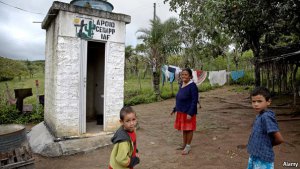London, England (CNN) — In Ghana’s capital, Accra, the streets are choked with trash and littered with plastic waste that blocks gutters and clogs storm drains.
Drinking water comes in sachets that cost a few cents. Cheap and convenient, they are sold in shops and by street hawkers. But once they have been drunk they are often simply dropped on the ground.
When British entrepreneur Stuart Gold saw Accra’s plastic problem he recognized an opportunity for a business venture — an NGO that could clean up the streets and create jobs in the community.
His idea was to collect discarded sachets, clean them up and stitch them together to make brightly colored, fashionable bags.
Two-and-a-half years later, Trashy Bags makes around 250 items a week and produces 350 different designs of bags, wallets and raincoats.
And crucially, its network of collectors has gathered some 15 million plastic sachets that might otherwise be on the streets of Accra.
“One of the problems in Ghana is the amount of plastic littering the streets,” Gold told CNN. “There isn’t a proper way of collecting waste and people aren’t educated as to the problems of plastic waste.
“The pure-water sachet is ubiquitous. When anyone wants water they can’t drink tap water so they buy these sachets, even for their home.
“Once they’ve drunk the water they drop it in the street. You can see people drop them from their cars,” he said.
Gold said that while waste collection is slowly improving in Accra, recycling is still in its infancy and landfills are inadequate.
Plastic dumped in the streets ends up blocking drains, which Gold said can cause seasonal flooding. Other waste makes it into the sea, with unsightly tangles of plastic bags washing up on the beaches to the east of Accra, he said.
Trashy Bags encourages people to bring them empty sachets, paying about 20 cents for each kilogram of water sachets (about 100 sachets) they deliver. It pays more for ice cream, fruit drink and yogurt sachets, which are harder to come by.
The sachets are sorted, hand washed, disinfected and dried in the sun, before being flattened by hand and stitched into sheets.
The sheets are then cut according to templates and assembled as finished bags, wallets and even rain jackets.
It’s a labor-intensive process that means Trashy Bags products are more expensive than mass-produced items, according to Gold.
Prices range from $1 for a wallet to $26 for sports bags and Gold said most of his products are bought by expats and tourists, or exported to countries including Japan, Germany and Denmark.
But he added that Trashy Bag’s reusable shopping bag, which costs about $4.30, is proving a hit with Ghanaians.
And the labor-intensive manufacture does mean jobs for locals. Trashy Bags currently employs 60 Ghanaians in its workshops and around 100 others collect sachets for the company
“For lots of people collecting sachets is their whole livelihood,” said Gold.
“One woman makes more money than any of our actual workers. She organizes other women to collect and she pays them and she brings the sachets in.”
The result, said Gold, is that instead of discarding sachets, some people are keeping them and selling them on to collectors.
He acknowledged that Trashy Bags’ efforts are only a drop in the ocean of waste, and that despite his goal of turning the NGO into a self-sustaining venture it is struggling to break even.
But he said an important part of the project is education. Whereas a number of clothing companies around the world use materials made from recycled plastic, Trashy Bags are visibly made from the original plastic packaging.
“We don’t melt it down, so it’s very obvious it’s made from recycled plastic trash. So, the Ghanaians love them, and they do appreciate the solution because it’s very graphic,” said Gold.
There are similar projects to Trashy Bags in other countries. “Bazura Bags” in the Philippines makes bags from offcuts left over by packaging companies, India’s “Thunk in India,” makes all kinds of recycled products, including pencil cases made from fruit juice cartons, and “Terracycle” in the United States makes a range of items, including backpacks made from cookie wrappers.
It’s a sign that attitudes to waste are changing around the world. And in Ghana too. The government has acknowledged there is a problem with plastic waste and has even talked about banning plastic.
While a ban may be unrealistic, the fact it has been considered is a sign the environment is a growing concern in the country.
“People in West Africa don’t take the environment particularly seriously, but more and more in Ghana they do,” said Gold.
“They are gradually seeing there are problems other than just disease, and [polluting] the environment is one of them.”
Source – CNN, June 1, 2010






